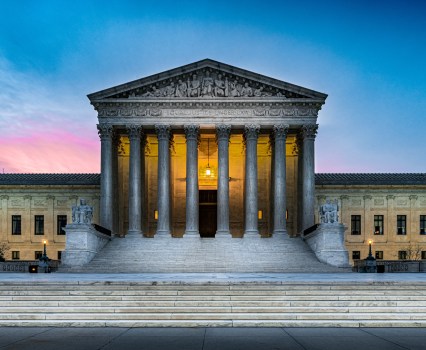The new Supreme Court Term that began this week currently includes few blockbuster cases.
To be sure, there are a handful of higher-profile issues on the docket. In United States v. Skrmetti, the Court will decide whether a Tennessee law that bans gender-affirming care for minors violates the Fourteenth Amendment’s guarantee of equal protection. Because nearly half of the states now have similar laws, the ruling could have far-reaching consequences.
Yesterday, the Court heard oral argument in Garland v. VanDerStok, which involves a challenge to federal regulation of so-called ghost guns. And later this Term, in another case involving guns, the Justices will consider whether Mexico’s lawsuit against U.S. firearms manufacturers for allegedly targeting the illegal gun market there fits within an exception to a federal law granting them immunity against civil liability.
For the most part, however, the Supreme Court docket presents technical legal questions that the general public would have difficulty even understanding, much less caring about.
For those of us dismayed by the Roberts Court’s rulings over the last several years moving the law far to the right, a relatively quiet Term is a blessing. The fewer important cases the Court decides, the fewer opportunities its conservative supermajority has to ignore, rewrite, or discard longstanding precedents set by their less reactionary predecessors.
Unfortunately, however, the Supreme Court can and typically does add cases to the docket during the Term. In this year when Donald Trump is once again the Republican Party nominee for President and once again making unfounded assertions that Democrats will try to steal the election from him, there is reason to believe that the Justices will find themselves adjudicating the outcome. Should Trump lose the election, he is very likely to challenge the outcome in multiple fora. A sleepy SCOTUS Term could become much too exciting in the next several months.
The Roberts Court’s Track Record in Elections
Writing for a plurality in the 1946 case of Colegrove v. Green, Justice Felix Frankfurter warned that if courts were to rule on challenges to malapportioned congressional districts, they would be entering a “political thicket.” The Supreme Court would render that decision obsolete sixteen years later in a landmark ruling that paved the way for recognition of the bedrock principle that districts should be apportioned in accordance with the rule of one-person-one-vote. But Frankfurter was not wrong that when the courts decide cases with direct partisan implications, they risk appearing—and sometimes actually being—partisan.
The Roberts Court has sometimes paid lip service to Frankfurter’s caution. One hears echoes of Frankfurter’s view in Rucho v. Common Cause, in which Chief Justice John Roberts wrote for the Court that federal constitutional challenges to political gerrymandering are beyond the competence of courts. But more often, the Supreme Court over the last two and a half decades has seemed undeterred, as it has used a veritable machete to slice through election law and leave a distinctive trail.
That trail has been remarkably favorable to the institutional interests of the Republican Party. In Rucho itself, the Court’s rejection of challenges to political gerrymandering worked to Republican advantage. True, both Republican-dominated and Democratic-dominated state legislatures engage in political gerrymandering. Rucho itself involved one of each. But in recent years, Republicans have been more aggressive and more effective at gerrymandering. Keeping federal courts out of this area systematically works to Republican advantage.
In other settings, the Roberts Court has been happy—seemingly eager—to adjudicate when doing so benefited Republican partisan interests. For example, in 2013, the Court invalidated a linchpin of the Voting Rights Act, thus undercutting key protection for Black and other minority voters, who tend to vote for Democrats. In a 2021 case, Justice Samuel Alito wrote for the conservative supermajority—over the dissent of three Democratic appointees—that Arizona’s interest in preventing fraud justified certain restrictions on voting. The Court thus validated the Republican strategy of enacting voting restrictions that disparately suppress Democratic votes in the interest of suppressing voter fraud, despite the absence of any evidence of more than a tiny handful of instances of such fraud.
And then, of course, there is Bush v. Gore, in which the Court’s conservatives all sided with the Republican candidate for President. True, that case was handed down under Chief Justice William Rehnquist—but it was of a piece with the Roberts Court precedents it was to usher in. Moreover, three of the six Justices who now comprise the conservative supermajority worked as lawyers for George W. Bush in that case: John Roberts, Brett Kavanaugh, and Amy Coney Barrett.
Will it be Different this Time?
But wait. What about the Supreme Court’s performance in the aftermath of the 2020 presidential election? Didn’t the Court reject every effort by Trump and his allies to overturn the election? And doesn’t that suggest that there is a limit to the Court’s willingness to act in a nakedly partisan fashion?
Yes and no.
With two exceptions, the cases I’ve described involved challenges to procedures under which elections would be conducted. Only in Bush v. Gore and the 2020 cases did the Court confront litigation following a very consequential election. And the principle that reconciles its performance in those cases could portend trouble this time around.
In 2020, some observers suggested that the reason the Court didn’t intervene to help Trump was that his claims were so weak—too weak to be even within shouting distance of a plausible argument that the Justices could latch onto as an ostensibly non-partisan justification for ruling in Trump’s favor. There may be something to this suggestion, but I’m dubious. The Supreme Court has shown itself fully capable of making the most laughably bad arguments in the service of reaching a result it wants to reach.
Don’t believe me? Consider that the Constitution states that government officials, including the President, who may be impeached and removed for official conduct involving “treason, bribery, or other high crimes and misdemeanors” are also “subject to indictment, trial, judgment and punishment . . . .” And yet, the Supreme Court just a few months ago proclaimed that former Presidents are almost entirely immune from criminal prosecution.
To my mind, the key to reconciling Bush v. Gore and the Trump cases in 2020 is that the Court sided in each instance with the candidate playing defense. In 2000, Al Gore was trailing in the vote count in Florida, so he went to court seeking a different result. In 2020, Trump was trailing in multiple states he needed to win the Electoral College, so he and his allies went to court seeking a different result. In a somewhat rare display of evenhandedness across the two cases, the conservatives in both instances decided that courts—including state courts like the Florida Supreme Court in 2000—should stay out of the political thicket once the votes are being counted.
That might sound like good news—and it will be if Trump goes to court seeking to overturn the results of the 2024 election. But this time around, Trump might not need to go to court. Even if he loses the popular vote in key swing states, Trump might rely on his loyalists in state legislatures or other organs of government to declare him the winner. Should he do so, it would be Kamala Harris who would need to take the matter to the courts. If so, the conservative super-majority’s aversion to the post-election thicket and its preference for Republicans would align.
#Election #Case #Reaches #SCOTUS #Side #Playing #Defense #Michael #Dorf #Verdict










